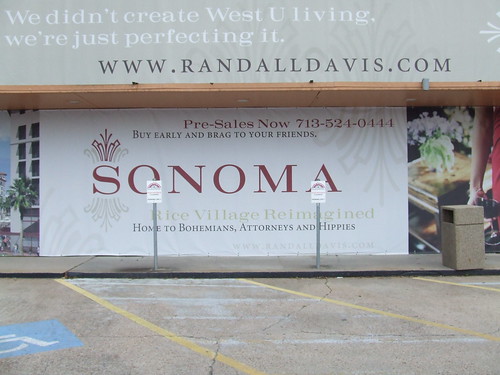I love having an excuse to run this picture:
Lisa Gray looks at my favorite development project and wonders if it really will – or even can – be all that.
Sonoma itself doesn’t seem concerned about even the shallowest forms of authenticity. “The Rice Village Re-Imagined,” proclaim banners facing Bolsover, but it’s not clear whether it’s being re-imagined as California or Italy. The name screams West Coast, but [developer Randall] Davis seems to favor Italy. A while back, he told Houston Chronicle reporter Nancy Sarnoff that the pedestrian space planned between the buildings will resemble a European plaza with Italian cypresses and palm trees. Viva Italifornia.
Or really, viva anywhere. The Mediterranean Revival architecture you see in the architects’ drawings could be a slick new development in any city at all, from Los Angeles to Hong Kong, or maybe in The Woodlands. Just because a development is walkable doesn’t mean it has a sense of place.
Wherever Sonoma is pledging its stylistic allegiance, it’s not to the Rice Village.
But will that matter? Will cultural creatives care, given shiny Viking appliances and interesting shops a couple of blocks away?
Gray goes on to suggest maybe they won’t. Me, I’m not so sure that matters. I look at the genericizing of Montrose and parts of the Heights and think that there’s an awful lot of people out there with more money than taste. You can certainly argue either way about whether it’s a good thing or not, but in the end I think shiny new buildings with high-end amenities do pretty well regardless of what cultural sins they may be committing. I wouldn’t bet against it, is all I’m saying.


Speaking of business signs (and this is way OT) but yesterday I noticed a big banner sign on the local HEB here in Waco. Something to the effect of:
Career Opportunities?
TXT: HEBxxxx…..
I must really be getting old if job announcements are being done by text message. Thought it was a real sign of the times.
Whenever comments like these arise, I always go back and read about the master-planned developments with plenty of input (and veto power) from nearby single-family residential neighbors, advocates for affordable housing, etc. that ended up as the best urban environments we have today, in places like the aforementioned Italy, or Greenwich Village, or San Francisco, or whatever.
Sorry for any sarcasm detectors I may have destroyed.
The “sense of place” in urban environments accretes over time through economic activity that focuses to the street and encourages pedestrian activity. It has never developed by listening to NIMBY neighbors or people who want to force affordable housing on new big buildings but not on existing single-family neighborhoods or who want to force their sense of aesthetics on a property owner. It has instead developed organically as people built individual buildings which weren’t required to provide any parking; which were allowed to build essentially how they wanted for whatever clientele they wished.